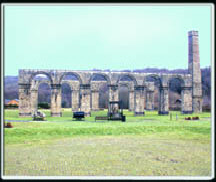
Abercrave, Ystradgynlais and the Coal and Metal Industries
The Level Fawr, Gwaun-y-Clawdd, International ( Candy) Colliery) and Abercrave collieries on the Drum Mountain, across the Swansea Valley from Abercrave, exploited both the upper and lower coal measures. The lower measures, which are much older and more compressed, contain some of the hardest anthracite in Wales. This is known locally as "blue diamond" as it has a blue sheen and is so hard that it has been used to make decorative ornaments. It can be handled without leaving traces on the skin.
Only one deep mine still operates in Wales today and that is the "Tower Colliery" at Hirwaun near Aberdare.

The upper coal measures, are less compressed and softer but are still a form of anthracite, which is low in volatile matter and consists mainly of carbon.
In 1820 "The Iron Master" David Thomas, working at Ynyscedwyn Ironworks in Ystradgynlais, developed a method for using local anthracite, instead of coke, for smelting iron. Anthracite remains solid when burnt, thus allowing the essential airflow to be maintained through the "charge" in an iron furnace. The early iron industry also relied on a supply of limestone, which was mixed with the charge in the blast furnace to act as a "flux" for the unwanted minerals and ash. These could then be "run off" from the bottom of the furnace during the smelting process.
The Swansea Valley was also renowned for "tin and copper production" and a part of the rather ornate old tin works in Ystradgynlais is preserved as a monument to its metal industries. The tin ores were shipped across the Bristol channel from Cornwall to Swansea where the coal was available to convert it into metal. Copper, lead and silver were also smelted locally and the valley became a major source of these metals and their numerous alloys, such as spelter, bronze and pewter. Silica sand from the Cribarth Mountain was used to make refractory bricks for the furnaces
The Cribarth Mountain forms the Western side of the Upper Swansea Valley between Abercrave and the National Showcaves for Wales. From the South it has the appearance of a sleeping giant (see picture far left). It was the main source of limestone and silica sand for the local iron industries and it shows ample evidence of working in the past (see picture >)
In Abercrave itself, School Rd is an extension of the old "dram- way", an "inclined plane" who's cutting runs up the Cribarth to the old limestone quarries. Drams (steel wagons) filled with limestone or silica sand were lowered down the long incline to the canal for off loading into boats. The descending loaded drams pulled the lighter, empty drams, back up to the top. The bed of the old dram way can still be followed to the top of the Cribarth mountain (see picture immediately to the left).
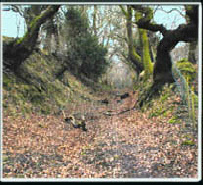
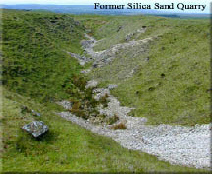
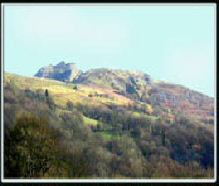
At the base of the Cribarth Mountain the Swansea Valley Canal extended as far North as Henneuadd Dock in Abercrave and was used to transport coal, limestone, silica sand and iron ore. It is still in evidence and navigable lower down the valley towards Pontardawe and Swansea.
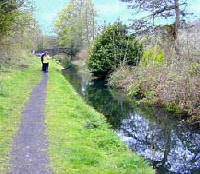
There are numerous industrial heritage sites in the area, such as the Ynyscedwyn Ironworks which pioneered the production of iron and steel from anthracite. (see picture on right >)
The combination of natural materials, economical bulk transport systems such as rail and canals, and the technology developed in the area made South Wales the powerhouse of British industry in the 1800's and 1900's.
It was the legacy of much earlier times however which made all this possible. Most of the valley's mineral deposits had begun forming around 500 million years earlier, long before the time when Dinosaurs first walked on the Earth.
The more recent forces which also shaped the region are described on the next page.......
